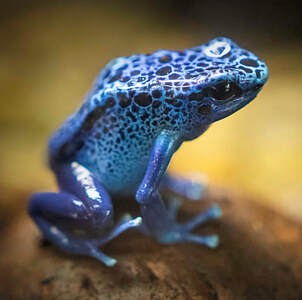Blue Poison Dart Frog

Scientific Name: Dendrobates tinctorius azures
Physical Description: A subspecies of the Dyeing Poison Dart Frog, the Blue Poison Dart Frog is characterized by a bright blue back and head, and a darker blue underside and limbs. Dark blue and black spots speckle the frog’s body. These bright colors serve as aposematic coloration, or a warning sign to predators that should they be consumed, they are toxic. The Blue Poison Dart Frog weighs about 8.5 grams on average and grows 1 – 1.5 inches in length2.
Blue Poison Dart Frogs have adhesive or “sticky” pads on their toes which aid in climbing, with males having larger pads, called nuptial pads, also present to help hold onto a mate during reproduction.
Habitat: They live in forests and inland wetlands1. Wetlands are considered one of the most imperiled habitats, and the range of suitable habitats for this species is declining due to human encroachment.
Range: They live in northern Brazil, Guyana, French Guiana, Suriname1
Diet: As insectivores, the Blue Poison Dart Frog eats a wide variety of insects such as ants, beetles, and flies.
Life Span: They live 4-6 years in the wild and up to 12 in human care2.
Social Structure: Blue Poison Dart Frogs breed during the Southern Hemisphere summer months of February and March where males produce a unique call to attract a mate with large egg masses then fertilized.
Status: Least Concern1
Other: Their toxicity comes from their diet2, with the alkaloids ingested then secreted through their skin. In a human-raised setting with an altered diet, the Blue Poison Dart Frog loses its toxicity!
1 https://www.iucnredlist.org/species/55204/11265402
2 https://cosleyzoo.org/blue-poison-dart-frog/
Physical Description: A subspecies of the Dyeing Poison Dart Frog, the Blue Poison Dart Frog is characterized by a bright blue back and head, and a darker blue underside and limbs. Dark blue and black spots speckle the frog’s body. These bright colors serve as aposematic coloration, or a warning sign to predators that should they be consumed, they are toxic. The Blue Poison Dart Frog weighs about 8.5 grams on average and grows 1 – 1.5 inches in length2.
Blue Poison Dart Frogs have adhesive or “sticky” pads on their toes which aid in climbing, with males having larger pads, called nuptial pads, also present to help hold onto a mate during reproduction.
Habitat: They live in forests and inland wetlands1. Wetlands are considered one of the most imperiled habitats, and the range of suitable habitats for this species is declining due to human encroachment.
Range: They live in northern Brazil, Guyana, French Guiana, Suriname1
Diet: As insectivores, the Blue Poison Dart Frog eats a wide variety of insects such as ants, beetles, and flies.
Life Span: They live 4-6 years in the wild and up to 12 in human care2.
Social Structure: Blue Poison Dart Frogs breed during the Southern Hemisphere summer months of February and March where males produce a unique call to attract a mate with large egg masses then fertilized.
Status: Least Concern1
Other: Their toxicity comes from their diet2, with the alkaloids ingested then secreted through their skin. In a human-raised setting with an altered diet, the Blue Poison Dart Frog loses its toxicity!
1 https://www.iucnredlist.org/species/55204/11265402
2 https://cosleyzoo.org/blue-poison-dart-frog/






